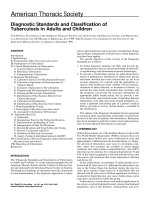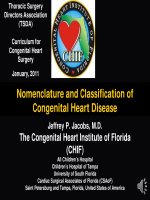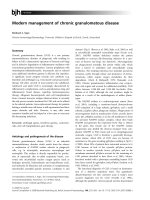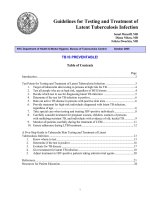Nomenclature and Classification of Congenital Heart Disease doc
Bạn đang xem bản rút gọn của tài liệu. Xem và tải ngay bản đầy đủ của tài liệu tại đây (865.01 KB, 32 trang )
Nomenclature and Classification of
Congenital Heart Disease
Jeffrey P. Jacobs, M.D.
The Congenital Heart Institute of Florida
(CHIF)
All Children’s Hospital
Children’s Hospital of Tampa
University of South Florida
Cardiac Surgical Associates of Florida (CSAoF)
Saint Petersburg and Tampa, Florida, United States of America
Thoracic Surgery
Directors Association
(TSDA)
Curriculum for
Congenital Heart
Surgery
January, 2011
Cardiac Description
1. the segmental anatomy of the heart
2. the classification of the cardiac lesion
3. the description of the cardiac lesion
Left and Right
For cardiac chambers:
‘‘left’’ refers to morphologically left
and
‘‘right’’ refers to morphologically right.
Cardiac Relations
and Cardiac Connections
Cardiac relations describe the broad interspatial
relations between the various cardiac
structures.
Cardiac connections describe the specific
mechanism by which two cardiac structures
connect to each other regardless of their
interspatial relations.
Segmental Approach
Van Praagh & Vlad
1. the sidedness of the atrial chambers, or, in
other words, the atrial “situs”,
2. the ventricular topology, in other words, the
ventricular “loop”, and
3. the relationships of the arterial trunks in
space
Atrial ‘‘situs’’
(the sidedness of the atrial chambers)
• The viscera and atria: The types of visceroatrial situs
– S solitus (otherwise known as normal arrangement)
– I inversus (or the mirror-imaged arrangement)
– A ambiguus
‘‘Situs ambiguus is defined as an abnormality in which there
are components of situs solitus and situs inversus in the
same person. Situs ambiguus, therefore, can be considered
to be present when the thoracic and abdominal organs are
positioned in such a way with respect to each other as to be
not clearly lateralized and thus have neither the usual, or
normal, nor the mirror-imaged arrangements.’’
Visceral Situs
William T. Mahle, MD
Associate Professor of Pediatrics
Emory University School of Medicine
Norman H Silverman
Stanford University
Lucile Packard Children’s Hospital
Ventricular Topology
(Ventricular Loop)
• The viscera and atria: The types of visceroatrial situs
– S solitus
– I inversus
– A ambiguus
• The ventricular topology
– D D-loop ventricles,
– L L-loop ventricles
Morphologically Right Ventricle
Robert Anderson
Robert
Anderson
Morphologically Left Ventricle
VENTRICULAR TOPOLOGY
– Robert Anderson
Right hand
Left hand
The Great Arterial Position
• The viscera and atria: The types of visceroatrial situs
– S solitus
– I inversus
– A ambiguus
• The ventricular topology
– D D-loop ventricles,
– L L-loop ventricles
• Great vessels: The great arterial position
– S solitus
– I inversus
– D dextro
– L levo
Jacobs JP, Anderson RH, Weinberg P, Henry L. Walters III HL, Christo I. Tchervenkov CI, Del Ducae D, Franklin RCG,. Aiello VD,
Béland MJ, Colan SD, Gaynor JW, Krogmann ON, Kurosawa H, Maruszewski B, Stellin G, Elliott MJ. The
nomenclature, definition and classification of cardiac structures in the setting of heterotaxy
.
In 2007 Supplement to Cardiology in the Young: Controversies and Challenges Facing Paediatric Cardiovascular
Practitioners and their Patients, Jacobs JP, Wernovsky G, Gaynor JW, and Anderson RH, editors. Cardiology in the
Young, Volume 17, Supplement X: XXX - XXX, 2007, accepted for publication, in press, 2007.
• Specification of the atrial “situs”, the
ventricular “loop”, and the relationships of
the arterial trunks in space does not specify
the atrioventricular and ventriculoarterial
connections.
These variables are separately specified.
The Sequential Segmental
Approach of Anderson
1. Atrial arrangement,
2. Atrioventricular connections, and
3. Ventriculoarterial connections
Atrial Arrangement
Robert
Anderson
Atrioventricular Connections
Robert
Anderson
Atrioventricular Connections
• Normal atrioventricular connections (Concordant
atrioventricular connections in biventricular heart)
• Discordant AV connections
• Mixed ("Ambiguous") AV connections (biventricular)
• Absent left sided AV connection
• Absent right sided AV connection
• Double inlet AV connection
• Double inlet AV connection, Double inlet LV
• Double inlet AV connection, Double inlet RV
Concordant Atrioventricular Connections with Discordant
Ventriculoarterial Connections
(TGA)
Robert H. Anderson, Paul M. Weinberg. The clinical anatomy of transposition. In: Jacobs JP,
Wernovsky G, Gaynor JW, and Anderson RH (editors). 2005 Supplement to Cardiology in the
Young: Controversies of the Ventriculo-Arterial Junctions and Other Topics, Cardiology in the
Young, Volume 15, Supplement 1: 1 - 198, February 2005.
Ventriculoarterial Connections
• Normal ventriculoarterial connections (Concordant
ventriculoarterial connections in biventricular heart)
• Discordant VA connections (TGA)
• Single outlet VA connection, Common arterial trunk
• Single outlet VA connection, Single outlet VA connection via aorta
(pulmonary atresia)
• Single outlet VA connection, Single outlet VA connection via
pulmonary trunk (aortic atresia)
• Double outlet VA connections, Double outlet LV
• Double outlet VA connections, Double outlet RV
• Concordant VA connections with parallel great arteries
(anatomically corrected malposition)
Jacobs JP, Anderson RH, Weinberg P, Henry L. Walters III HL, Christo I. Tchervenkov CI, Del Ducae D, Franklin RCG,. Aiello VD,
Béland MJ, Colan SD, Gaynor JW, Krogmann ON, Kurosawa H, Maruszewski B, Stellin G, Elliott MJ. The
nomenclature, definition and classification of cardiac structures in the setting of heterotaxy
.
In 2007 Supplement to Cardiology in the Young: Controversies and Challenges Facing Paediatric Cardiovascular
Practitioners and their Patients, Jacobs JP, Wernovsky G, Gaynor JW, and Anderson RH, editors. Cardiology in the
Young, Volume 17, Supplement X: XXX - XXX, 2007, accepted for publication, in press, 2007.
• Specification of the atrial arrangement, the
atrioventricular connections, and the
ventriculoarterial connections, does not
specify nor imply the ventricular topology, or
the relationships of the cardiac chambers and
great arteries in space.
These variables are separately specified.
Cardiac Position
Can be surgically important – for example –
Pathway for extracardiac Fontan
• Dextrocardia (right sided ventricular mass)
• Levocardia (left sided ventricular mass)
• Mesocardia (central/midline ventricular mass)
• Dextroversion (ventricular apex points to the right)
• Levoversion (ventricular apex points to the left)
Cardiac Position
Jacobs JP, Anderson RH, Weinberg P, Walters III HL, Tchervenkov CI, Del Duca D, Franklin RCG, Aiello VD, Béland MJ, Colan SD,
Gaynor JW, Krogmann ON, Kurosawa H, Maruszewski B, Stellin G, Elliott MJ. The nomenclature, definition and
classification of cardiac structures in the setting of heterotaxy. In 2007 Supplement to Cardiology in the Young:
Controversies and Challenges Facing Paediatric Cardiovascular Practitioners and their Patients, Anderson RH, Jacobs JP,
and Wernovsky G, editors. Cardiology in the Young, Volume 17, Supplement 2, pages 1–28, doi:
10.1017/S1047951107001138, September 2007.
“Heterotaxy is synonymous with “visceral heterotaxy”
and “heterotaxy syndrome”. Heterotaxy is defined as
an abnormality where the internal thoraco-
abdominal organs demonstrate abnormal
arrangement across the left-right axis of the body.
By convention, heterotaxy does not include patients
with either the expected usual or normal
arrangement of the internal organs along the left-
right axis, also known as “situs solitus”, nor patients
with complete mirror-imaged arrangement of the
internal organs along the left-right axis also known as
“situs inversus”.”
Segmental Anatomy of the Heart
1. situs
2. ventricular topology (in other words, or
ventricular loop)
3. atrioventricular connections
4. ventriculoarterial connections
5. the relationships of the arterial trunks in
space
6.
the position of the heart and the orientation
of its apex









